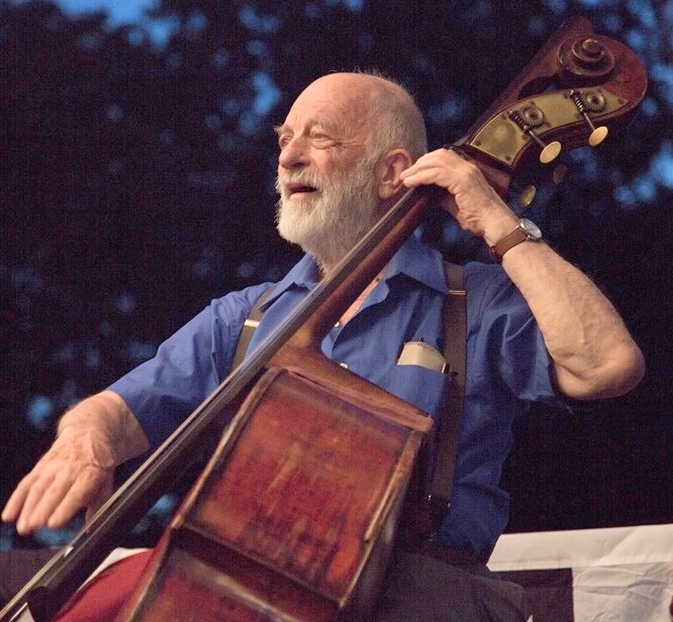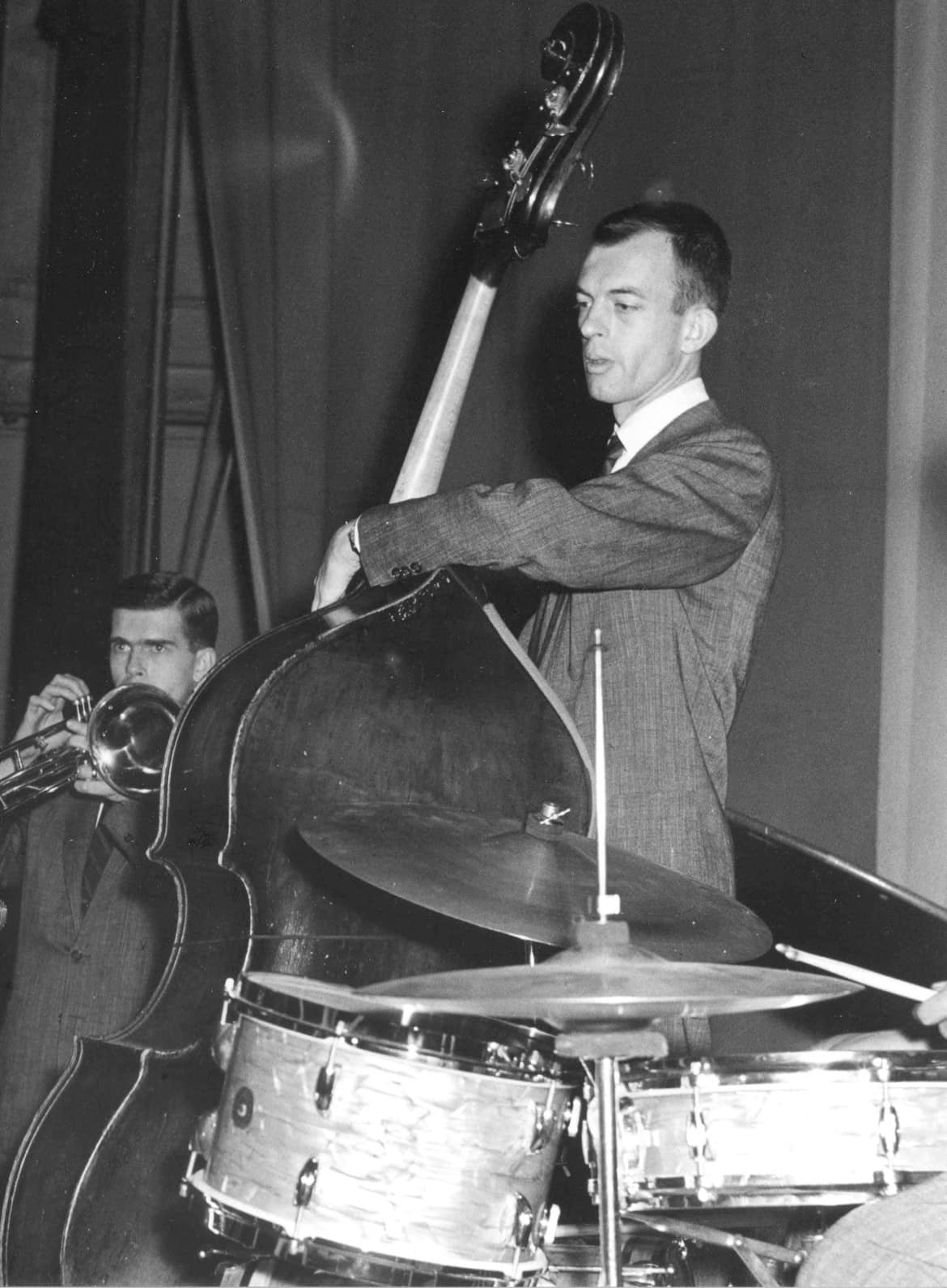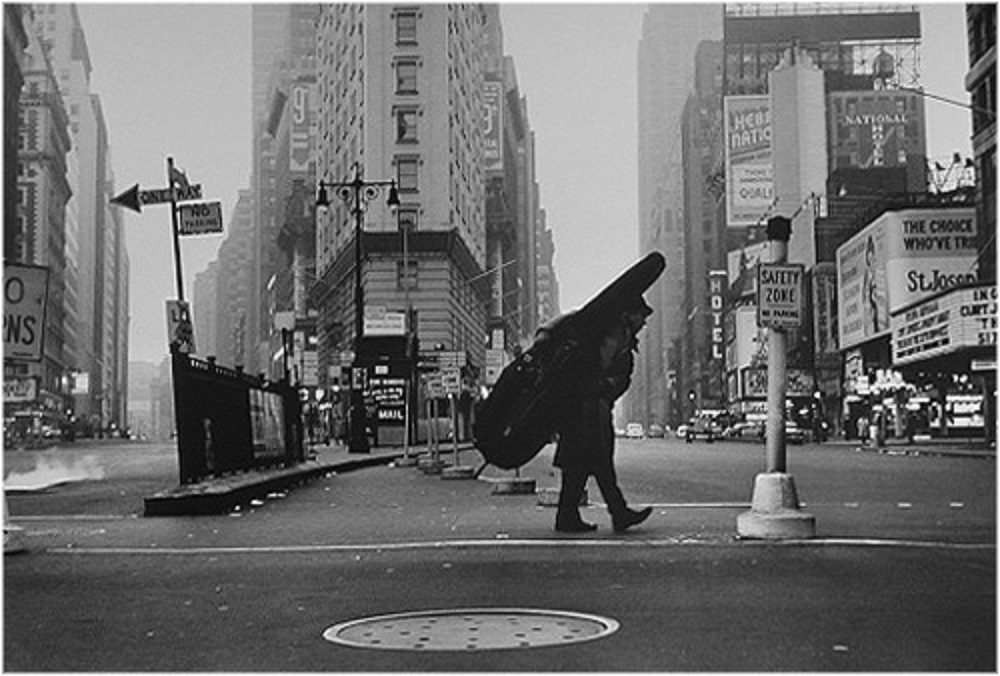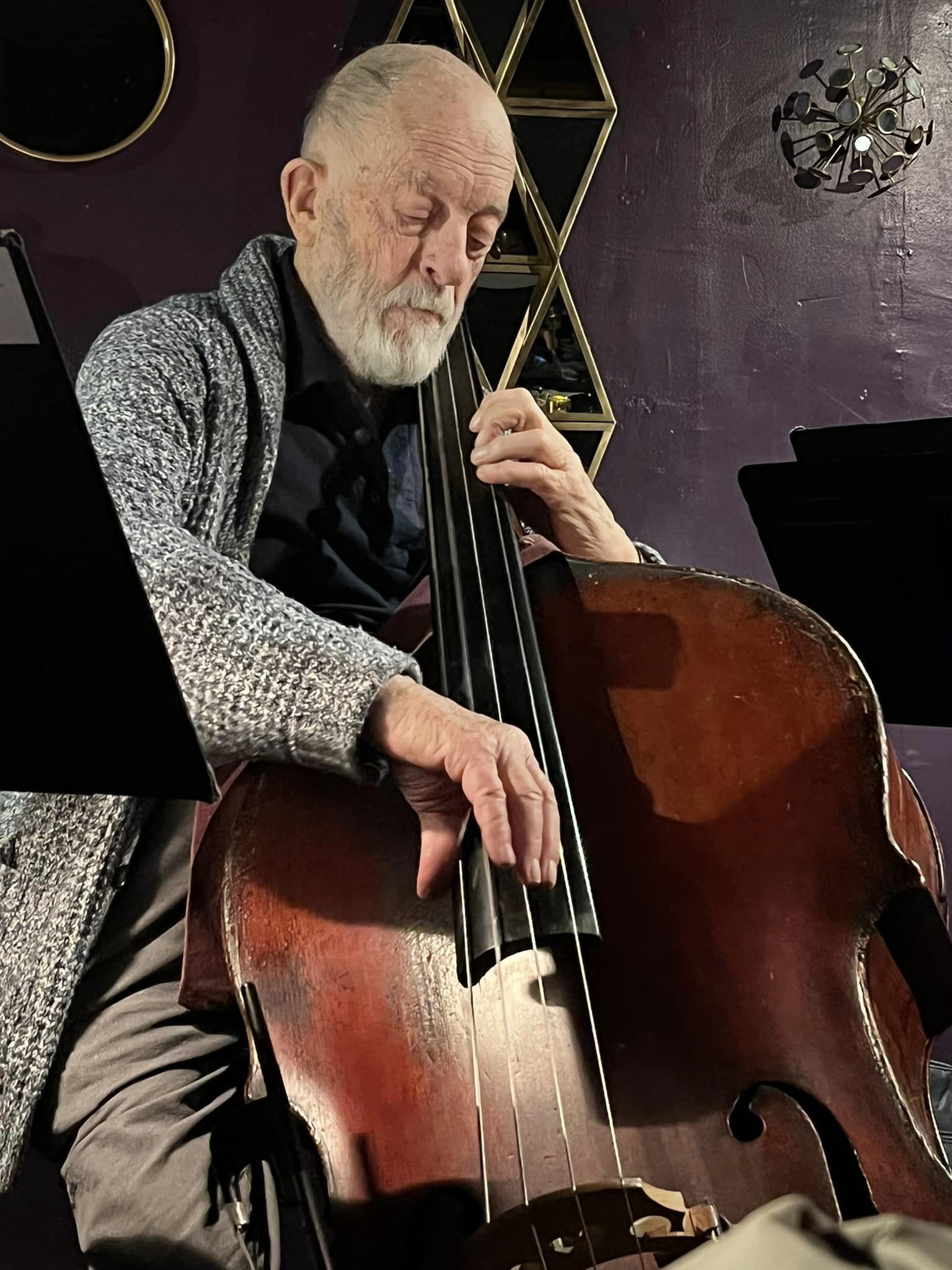There aren’t many musicians still around who began their careers in the late 1940s. Far fewer have the incredible memory of bassist Bill Crow, who is an articulate repository of jazz history. I recently had the pleasure to chat with Bill via Zoom. Our conversation dwelt mostly on his early life and career and this story will concentrate on that.
Born in 1927, Bill grew up in Kirkland, Washington, across Lake Washington from Seattle. His mother taught piano and singing and played the organ in church. In an era where much programming was local, she sang professionally on the Gold Shield Coffee Hour on radio station KIRO.
The family wasn’t well off and through the 1930s, recorded music in the home was supplied via an Edison wind-up gramophone, which played cylinders, mostly of light classical music and vaudeville routines (Bill still remembers the words to “Young Johnny Jones,” which he sang to me on the Zoom). The family eventually got a radio and Bill was glued to it. He showed a musical ear right away and started to acquire knowledge of popular and swing tunes.
Bill’s mother had tried to start Bill on piano when he was in Kindergarten, but it didn’t take. Not long after, his grammar school teacher showed students pictures of instruments they might play and Bill picked out the trumpet. It may have been because the teacher had played Louis Armstrong’s “West End Blues” in class, which amazed him (it was also the first time he’d seen a “flat two-sided record”).
On the heels of hearing Armstrong, he began to frequent a booth in an electronics store where he could sit and listen to 78s. He took home what he could afford, using money earned from a paper route and working after school in a print shop and a butcher shop. He memorized not only the tunes, but also the names of the musicians on the labels. “I got some Mary Lou Williams records with Bill Coleman and the Condon jam sessions on Commodore. That’s how I got introduced to Jack Teagarden and Ellington. I just fell in love with Johnny Hodges. Earl Hines, and Art Tatum—that was really piano playing. Vic Dickenson, Edmund Hall…”
His family got him a trumpet from the Sears catalogue for nine dollars, but after a couple of years, Bill was frustrated at not being able to play in the high register of the horn. His teacher looked at his teeth and suggested he go to a larger mouthpiece and play baritone horn, one of which the school owned. It was to remain his main instrument all through high school and most of the way through his stint in the Army.
He played in the high school concert band, where he “subbed on percussion,” and in the orchestra, where he would play cello parts on the baritone. His jazz listening and good ear had some effect, as he would extemporize on some of those lines. When his section mate complained, the teacher said: “for him, that’s okay.” Bill got involved in solo contests—“Things like ‘Stars in a Velvety Sky’ and ‘Sounds From the Hudson’” and eventually he had success in a couple of statewide contests. All the while, he was keeping up with the jazz repertoire, “In those days, jazz and pop were very close to each other. On juke boxes, you’d have Ellington, Goodman, Dorsey.”
 He wanted to join the swing band that had started up at his school, but there were no parts for baritone horn. Bill’s older brother had abandoned his own attempts to play the alto sax so he dug it out from under the bed and learned enough to get in the band. Due to an accident, he’d lost feeling in a couple of fingers and wasn’t able to be confident about fingerings. When his high school merged with another school and more experienced and able alto players joined the band, he decided he’d drop the alto and pick up more percussion skills. The previous drummer had graduated, so Bill went to the gas station where he worked and picked up enough to become the band’s drummer. He’d continue to use his percussion skills for years.
He wanted to join the swing band that had started up at his school, but there were no parts for baritone horn. Bill’s older brother had abandoned his own attempts to play the alto sax so he dug it out from under the bed and learned enough to get in the band. Due to an accident, he’d lost feeling in a couple of fingers and wasn’t able to be confident about fingerings. When his high school merged with another school and more experienced and able alto players joined the band, he decided he’d drop the alto and pick up more percussion skills. The previous drummer had graduated, so Bill went to the gas station where he worked and picked up enough to become the band’s drummer. He’d continue to use his percussion skills for years.
After graduating high school in 1945, he went into the Army and in its typically efficient way, the Army wouldn’t let him join a band and made him a typist. However, he eventually met a Sergeant who said the base was putting a band together-the 51st Army band, and he was assigned to it. He later moved to the Second Army Band in Fort Meade, MD.
At first, the band didn’t have much to do and just “sat around and jammed.” When he was in basic training, there was a local DJ named Bob Koons who played jazz all night and invited them down to the studio to play. Koons had “rhythm section records”—a precursor to Jamey Aebersold’s Music Minus One. The DJ would play those and the guys would play along, with Koons claiming the result was “the latest recording.” Crow adds that back in those days, during a jam session, it was appropriate that when you soloed, you would start with the chorus made well known by the person associated with the tune. So, on an Armstrong tune for example, you’d start with an Armstrong chorus.
While recently de-segregated, the Army remained largely segregated and Bill’s band was all white. Bill told me how impressed he was when he saw a black infantry group on the parade ground. They wore pristine uniforms they’d had custom tailored, boots, and buttons shined and could juggle their rifles. Their drummers “played a boogaloo beat and they’re up on their toes swinging as they marched and I said ‘Man, I’m in the wrong army.’”
While in the Army, he met a trumpet player from Brookline, MA, named Ray Baram who worked with him on Dixieland tunes like “Jada” and “At the Jazz Band Ball.” He told Bill he should switch from baritone to valve trombone—it’s hard to play tailgate baritone horn—so they went to a music store and he picked up a 30-year old Conn.
He also met a trumpet player named Gene Kent who was hip to Charlie Parker and Dizzy Gillespie and they listened to a clear Channel station from Chicago with DJ Dave Garroway who played a lot of the new music. At first Bill didn’t really take to Bird “because he didn’t sound like Johnny Hodges. But there was just no denying what a wonderful musician he was.“
A smaller group from the Army band started to play at service clubs. Crow was playing percussion as well as valve trombone. “When it came time for my solo, I would keep the beat going and the trumpet player would play the top cymbal while I played a chorus.”
There were also some bassoon parts: “And with the plunger, I figured out a way to sound like a bassoon on the valve trombone. It was all great for my reading.”
When Bill got out of the army in 1949, he took some classes at the University of Washington and worked nights as drummer at the Cirque Club. After his gig, he sat in on bongos with Buzzy Bridgeford’s quartet at the VFW Club. He was playing trombone in a practice room at the college when a pianist named Kenny Gimble came in and asked him to a daily jam session at the college. Floyd Staniford, a local trumpet player, also invited him to join a rehearsal band.
He discovered and met a bunch of jazz players in Seattle, including the 18 year- old Quincy Jones, who was still in high school and a pianist everyone called R.C.—Ray Charles. “Quincy would go over to RC’s house everyday after school and learn changes.” Singer Janet Thurlough, future husband of trombonist Jimmy Cleveland, worked at a local record store Bill haunted and she introduced him to RC. I asked Bill how it felt to be in a mixed race situation for the first time: “I felt so glad that I was accepted by them. They had my music. I wanted to be with those guys.”
In fact, a bunch of those guys were living on a houseboat on Lake Union, near the college and Bill moved in. (“I got away from my mother’s Christianity”). It was cheap-no taxes and all they had to pay was water and electricity. “We’d wake up and one guy would be making coffee and eggs while the music started and after you played your chorus you’d go in and do some cooking or have something to eat. Then we’d go to school and when we came back at 4:40, the session would start up again.” Bill recalls that when Gene Ammons was in town with Woody Herman, he made it to one of those sessions.
He went with his pal Buzzy Bridgeford via bus to New York City with $50 in his pocket and his trombone. He thoroughly absorbed the New York scene, describing to me how he saw Dizzy Gillespie dancing around to conduct his big band and Chano Pozo balancing a water glass on his head as he played percussion. He had to learn how to scuffle—working a job at a printing press in the Bronx, babysitting, doing moving jobs—whatever it took. Bill took lessons with Lennie Tristano on valve trombone and singer Dave Lambert introduced him around and got him work on a vocal demo for Neal Hefti’s wife Fran Warren. John Benson Brooks, who was a songwriter and arranger, also helped him survive, letting him stay in a spare room at his place on 136th St. and Riverside Drive.

He was playing a summer job in the Adirondacks with a Buzzy Bridgeford group at the Altamont Hotel when Bridgeford got a string bass, told Bill to learn and Bill agreed. “I had the ear,” he says, “and it was just a matter of finding where the notes were.” With no teacher, he invented his own system of playing and didn’t actually learn the standard system until years later, when he studied with Fred Zimmerman of the New York Philharmonic.
He started to pick up work on the bass, but was still scuffling, “It took me a while to get a bass of my own. There was a place that would rent me one for $5 a weekend. I’ve have to rent a tux for $5 and that would leave me something to eat the rest of the week.” But he was accumulating credits and gaining a reputation. He played, sang, and did comedy with Glen Moore and his Mooremen, Mike Riley and his Musical Maniacs, and the Teddy Charles Trio while honing his bass playing.
He played with a John Benson Brooks group and Bill recalls a gig with the folk group the Weavers. The group had been blacklisted for political activities—this was the McCarthy era—and they were holding a concert at Town Hall to see if they still had an audience. Pete Seeger, who was with the Weavers, knew Brooks who said he would write up some horn charts and hired Bill, along with Bud Johnson, Benny Green, and Taft Jordan. Says Bill: “Jordan’s playing ‘Shenandoah’ was one of the most beautiful things I ever heard.”
Bill joined vibeist Teddy Charles’ trio when Charles’ bass player Kenny O’Brien left the group. They rehearsed everyday and worked every so often. When they lost their guitar player, Jimmy Rainey who had been with Stan Getz, joined the group. They worked at the Iroquois Hotel on 46th St. for a month. Getz came back from the West coast and called Rainey, inviting him to play in Boston with him and Roy Haynes at the Hi-Hat. They needed a bass player and Crow joined them for the gig “So that was my entree.” Bill had seen Haynes with Lester Young then with Bird and only a year later, he’s playing with him. To add to his case of jitters on the first night, one of the gut strings on his bass broke. He saw another bass under the piano and grabbed it, but it turned out to be a left-handed-strung bass and many wrong notes ensued. Happily, Getz was cool with it and when the tune was over, he gave Bill a minute to change the string.
The Hi-Hat turned into about six months of steady work with Getz, including several record dates. Frank Isola replaced Haynes and Kenny Clarke replaced him. Then Getz started a new group with Bill, John Williams, Alan Levitt, and Bob Brookmeyer. Brookmeyer couldn’t make the first two weeks, so Johnny Mandel subbed for him on trombone. In 1953, Getz replaced Bill with Teddy Kotick, and Bill moved over to Teddy’s gig with Claude Thornhill’s Orchestra. He tells of the time Thornhill was in New Orleans and needed a trumpet player. Al Hirt was suggested and Hirt could play all right, but well, let’s say it was not a match made in heaven and Hirt did not join Thornhill.
“My first two, three years,” Bill says, “I was always the one who needed the experience. Each job was like another lesson. They would hire me for something I could do, they liked my time or something, or my smile.” I suggest he had more to offer, but also that he was an easy guy to get along with. He was an early adopter of the Fender bass, which no doubt helped him work continuously.

From this point on, his career never hit a lull and he played with many of the finest musicians in jazz. After Thornhill, he moved to the Terry Gibbs Quartet, played occasionally with George Wallington, Don Joseph, Brew Moore, Billy Bauer, and Jerry Wald. He then joined the Marian McPartland Trio at the Hickory House in NYC. Bill says: “She taught me to play in every key.” He was the bassist with Gerry Mulligan’s sextet, quartet, and concert band during the mid to late 1950s and early 1960s. In 1956 he played with Jay and Kai (J.J. Johnson and Kai Winding), including at the Newport Jazz Festival. On July 24, 1958, he played one concert with Duke Ellington’s orchestra at Lewisohn Stadium—“one of the biggest thrills of my life.
I asked if he ever played with Billie Holliday, and he says “No, but I was sitting at Birdland listening to Slim Gaillard. Slim invited her up to sing and she was little drunk. But she sang an up tune and it sounded nice, then she sang a ballad and it sounded a little quavery holding notes and she just stopped. And right away Slim had his arms all around her and made up a song about ‘Billie Holliday I love you’ like she was the queen.”

In summer, 1962 he toured the Soviet Union with the Benny Goodman Orchestra. In 1965, although they hired the bass player for only three nights a week, he joined the house band at Eddie Condon’s club with Yank Lawson, Peanuts Hucko, Cutty Cutshall, Dave McKenna, and Morey Feld. When McKenna and Feld left, they were replaced by Dick Hyman and Cliff Leeman. Bill says that: “Condon was a lovable drunk…Once in a while he’d pick up a guitar and when he sat down, he knew the right chords, his time was good.”
He played society gigs for Peter Duchin and occasional bookings with the Bob Brookmeyer/Clark Terry Quintet when Mulligan had no gigs. From 1975 into the late 1990s he worked in the pit for Broadway shows, doubling on tuba and also gigged with Al Cohn and Zoot Sims. In 1983 he was elected to the Executive Board of Local 802, the musicians’ union of Greater New York, where he served for twenty years. For decades, he wrote a column for the AFM Local 802 newsletter.
Bill Crow is a true storyteller and anyone who wants the full flavor of the jazz life in the 20th century needs to check out his writing: Jazz Anecdotes was published in 1991. A revised and expanded paperback edition called Jazz Anecdotes, Second Time Around was published in 2005 and his autobiography, From Birdland to Broadway, was released in 2007. Bill has added immeasurably to jazz for the last 70 years and it’s wonderful to see that his love for the music continues to burn brightly.
Find Bill Crow online at www.billcrowbass.com.
Steve Provizer is a brass player, arranger and writer. He has written about jazz for a number of print and online publications and has blogged for a number of years at: brilliantcornersabostonjazzblog.blogspot.com. He is also a proud member of the Screen Actors Guild.






















